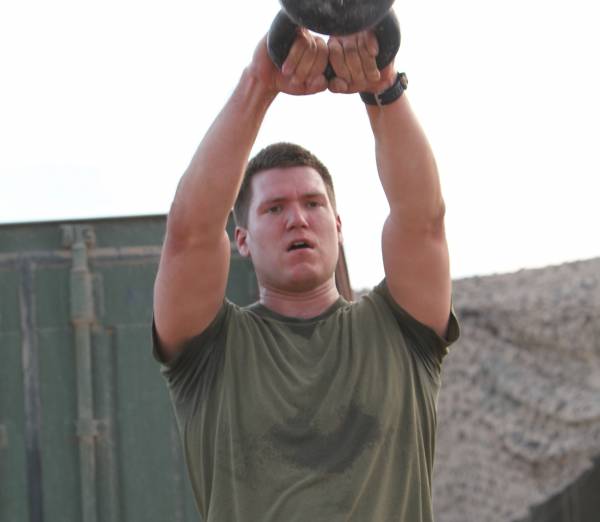When CrossFit, Inc. posted a link to this article on their Facebook page, a minor firestorm erupted. Minor, meaning mostly people from the RKC community, who are generally annoyed by CrossFit’s bastardization of their sport, spoke up that the logic presented by Greg Glassman that “a higher swing means more work accomplished” is flawed.
I’d like to explore several angles to this issue, including whether the America swing itself is valuable or a waste of energy and why the two sides are so vehement in their respective positions, as well as offer some thoughts about the use of kettlebells in CrossFit in general.
Why People Bicker
CrossFit has been very good at absorption. It’s like 1958’s The Blob, the plot of which is described as, “an alien lifeform consumes everything in its path as it grows and grows.” CrossFit has done just that, absorbing pieces of fitness from everywhere and repackaging them as its own. This includes weightlifting, kettlebells, self defense, running, and much more. In general, this is a good thing.
The problem lies when CrossFit envelops a sport or movements from a sport steeped in rich history and tradition, with rigid rules and techniques, and then pukes all over them in the name of speed and intensity.
Weightlifting is a good example. In the weightlifting world, pressing out a lift is general cause for red lights (a “no-rep” in CrossFit parlance). People who are loyal to the sport of weightlifting are appalled by CrossFit’s application of the word “snatch” and that we give credit for reps such as those where athletes drop to their knees to save a lift (dumb) or fight a missed lift with the world’s most hideous press-out (also dumb).
Similarly, with kettlebells, there is a history, a method, and what some might describe as a beauty in a properly executed kettlebell swing. So, when CrossFittters go and bastardize those swings, it pisses off the RKC folks, whether the particular swing might be good, bad, ugly, pretty, or injurious. You may as well have painted a kangaroo into the background of da Vinci’s The Last Supper. (Monty Python fans, you’re welcome)
“The problem lies when CrossFit envelops a sport or movements from a sport steeped in rich history and tradition, with rigid rules and techniques, and then pukes all over them in the name of speed and intensity.”
On the other side of the argument, many CrossFitters claim ownership of these newly crafted movements without any real regard to their value because, well, CrossFit says so. When you read some of the disputed article and see words like, “uniqueness of line of action,” “irreducibility,” “While admitting a penchant for iconoclasm, we are not contrary solely for the sake of being contrary. Rational foundations for our programming, exercises, and technique are fundamental to CrossFit’s charter,” you can’t help but be impressed. (I had to look up “irreducibility” to at least get myself some context.)
But while “uniqueness of line of action” and “irreducibility” sound impressive, the words mean little to the majority of people. We are simply being dazzled. So instead of doing any real analysis of the value of the overhead swing, we take CrossFit’s word for it. “Hey! It’s irreducible, alright? Get that goddamn thing over your head!”

CrossFit’s Reasoning
Let’s look at CrossFit’s reasons for swinging overhead. The first stated reason is:
We don’t do half rep pull-ups, we don’t do half rep squats, and we don’t do half rep push-ups. If there is a natural range of motion to any movement we like to complete it. To do otherwise seems unnatural.
So CrossFit considers a Russian swing a half rep. There’s one of the reasons you have the RKC community ruffled, guys.
Using that logic, CrossFitters would never deadlift. Rather, they should sumo deadlift high pull the bar every time they touch it. Better yet, just execute a narrow grip snatch every time you touch the bar because that’s the way to “lengthen the line of travel of any movement” as the article justifies.
“The goal is not always simply to ‘do more work.’ And you’ll never convince a powerlifter deadlifting 750lbs that he is only doing a ‘half rep.'”
The problem with this argument is that it disregards the purpose for a particular exercise. For example, the reason you practice a deadlift is different than the reason you practice a snatch. You’re not just looking for the longest possible range of motion. Deadlifts can be trained as a piece of the snatch or as their own end-goal. There are multiple variations of a deadlift, all of which serve different and varied purposes. The goal is not always simply to “do more work.” And you’ll never convince a powerlifter deadlifting 750lbs that he is only doing a “half rep.”
But that’s the difference between CrossFit and other sports in a nutshell. Other sports, in general, seek to execute the task specific to their sport. In weightlifting, everything is done in furtherance of the goal of executing a three-white-light snatch at the highest possible level. Snatch pulls, squats, Romanian deadlifts, good mornings, you name it, are all done in support of that single execution of technique.
In CrossFit, the goal is simple: more work. That is the technique. That is the execution of the test. So everything CrossFit does is done in furtherance of that goal – to perform more work. As such, any RKC argument that the “purpose of the kettlebell swing is to develop ballistic hip power” falls on deaf ears. That’s not what CrossFitters are interested in. They are only interested in how to do more work (in less time). They’re not training pieces of movements; they’re working. And they don’t care about your sport’s protocol. They really don’t.

The CrossFit Formula
But CrossFit, as a training methodology as expressed in a mathematical formula fails to take some nebulous variables into account – namely, goals. So when it comes to the American kettlebell swing, we see this formula:
Work (W) = The weight of an object x the height that object is lifted (why CrossFit takes the bell overhead)
W/Time (T) = Power (P) or, more accurate to CrossFit’s application, Intensity (I).
The bottom line is that for this formula (and for CrossFit’s substantiating formula) to be accurate, you simply must start with “W.” This means you need to move the heaviest possible weight the farthest or highest. That is CrossFit’s entire justification for the American swing as outlined in the referenced article, aside from that half-rep nonsense.
The upshot of this is that CrossFit will never not do the American swing, so we can all stop talking about it. It fits their math, so it’s going to be done. You can do more “work” with the American swing, and they have the anecdotal tables of data to prove it.
You Have a Choice
Here’s where I have an issue, though. There must, as some point on the matrix, be a place where W/T=P(I) crosses with Goals (G). That point in the matrix is the point at which the risk of injury becomes unacceptable.
More succinctly, you have to weigh the value of a particular movement against your goals. The value of a particular movement is its ability to provide the desired response, taking risk into consideration. In the case of the American swing, perhaps you can make the argument that more work is being done, the net result of which gets you “intensity.” But can you get the same level of intensity, the same ultimate power output, by doing Russian swings and not put your shoulders at risk?
“[Y]ou have to weigh the value of a particular movement against your goals. The value of a particular movement is its ability to provide the desired response, taking risk into consideration.”
Absolutely. Why not make up the alleged “loss of work” somewhere else? If the workout is kettlebells and burpees and you choose to do Russian swings but turn up the heat on the burpees – by resting less, going a little faster, or wearing a vest – can you, in theory, do as much “work” while keeping the swings from causing an uncomfortable shoulder impingement overhead? Yes.
Ultimately, it’s exercise. And you are going to get fit either way. So feel free to advise the coach that you are going to do Russian swings if you so choose, and then crank those burpees.
More Like This:
- 2 Safer Alternatives to the Overhead Swing
- Rationalizing the Swing: Why the American Swing Is Wrong
- 12 Sets of Advice on the Kettlebell Swing
- New on Breaking Muscle Today
Photo 1 by Justin Connaher via Wikimedia Commons.
Photo 2 courtesy of Jorge Huerta Photography.
Photo 3 by Cpl. Skyler Tooker via Wikimedia Commons.






